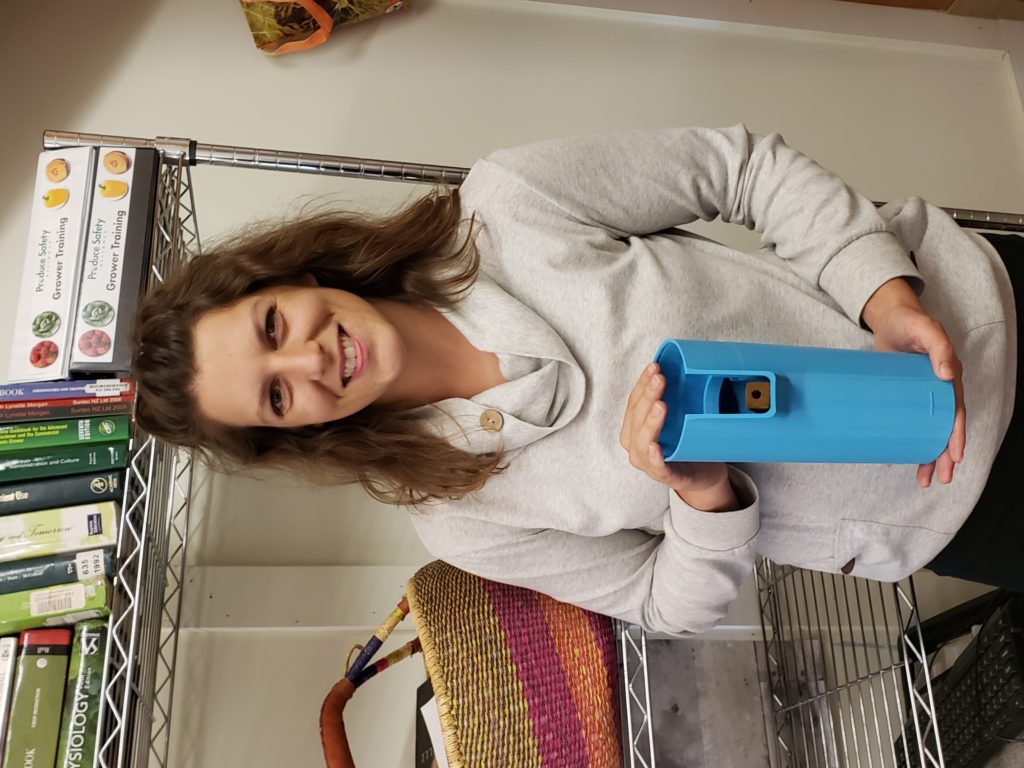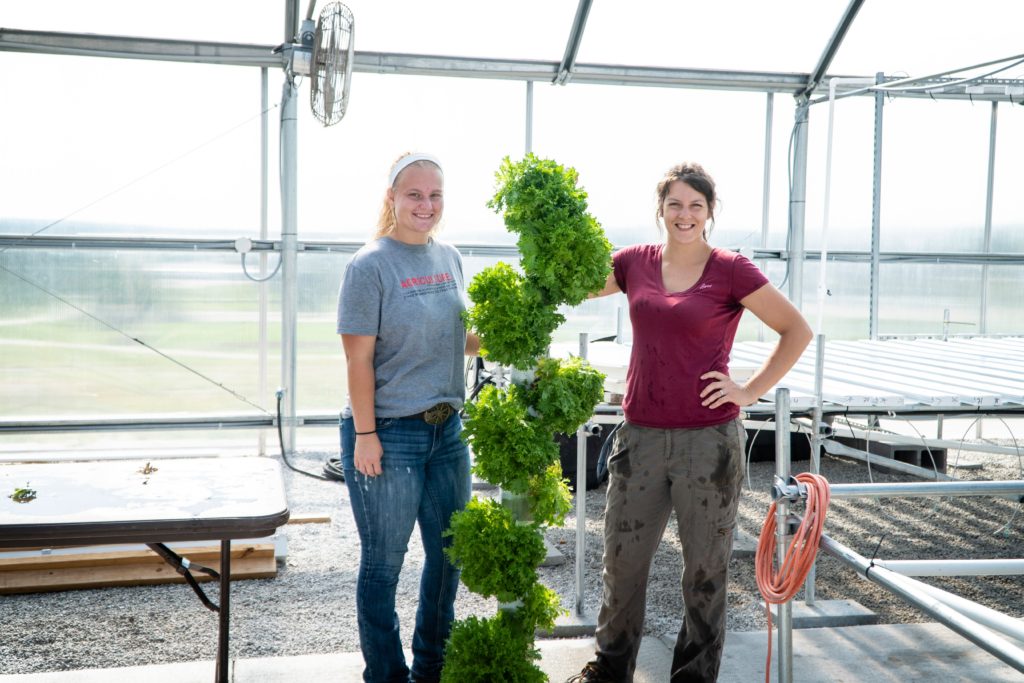GSS Group LLC has received a $600,000 grant to finalize development of a vertical hydroponic tower that can integrate with existing greenhouse and hydroponic production systems to increase crop-growing capacity.
The grant is through the U.S. Department of Agriculture’s Small Business Innovation Research program.

Farmers who invest in GSS Group’s Cascading Water Disbursement Tower (CWDT) will spend 85% less than it would otherwise cost them to purchase another greenhouse or bay, according to the company. At the same time, these producers can expect to increase their annual revenue by $11,000.
Challenges with Hydroponic Production
Danielle Dozier, CEO and president of GSS Group, attended more than 10 farm events since spring 2019 and stayed up-to-date on changes in technology to learn about her customers. She learned that hydroponic farm equipment such as controlled environment agriculture (CEA) greenhouses and hydroponic systems are typically very expensive.
Dozier explained, “The foundation, structure, and installation costs for a standard gutter-connected CEA greenhouse is $20 per square foot or $100,000 total. The majority of hydroponic producers grow crops such as leafy greens using Nutrient Film Technique and Deep-Water-Culture methods to distribute nutrients. The major disadvantage of these systems is the inevitable ‘dead-space’ or unusable production space created along the side-walls and connection bays of CEA greenhouses.”
Based on their interviews with over 60 small and mid-sized hydroponic farmers, GSS Group concluded that to become state-of-the-art within this industry, the CWDT vertical hydroponic system must be modifiable so it can be easily installed into different styles of greenhouse infrastructure.
The U.S. market for hydroponic systems is expected to double from 2019 to 2025, from $8 billion to $16 billion. Globally, the estimated value of crops produced through hydroponics in 2019 was $32 billion and is projected to grow at a 5.1% rate from 2019 to 2025.
Despite the growing demand for hydroponic systems and crops, hydroponic production methodologies are still relatively new and pose financial risks for the small to mid-size farms struggling to become profitable enterprises.
The Cascading Water Disbursement Tower Solution
GSS Group seeks to solve challenges faced by small to mid-sized farms in regards to business expansion with minimal investment.
“Our CWDT was designed to address the ‘dead-space-disadvantage’ created by the world’s leading hydroponic system type, NFT, as well as the technical problems that hinder vertical tower systems from being offered by big box horticulture product distributors,” Dozier shared.
Most vertical hydroponic towers today are bulky, heavy, and are composed of multiple components that must be cleaned after each harvest cycle (every 14-30 days). The commercial CWDT will be inexpensive, lightweight, and save users 30% of time spent on daily system maintenance tasks.
The CWDT was designed to be an efficient tool to maximize production capacity for existing hydroponic producers of various lettuces, herbs, and strawberries. “The design uses the same irrigation methods as NFT systems to reduce time spent on installation and integration. In addition, the vertical hydroponic tower is stackable to allow growers the ability to custom-fit the towers to their current operations,” said Dozier.
The Phase II Project
“The key outcome of the USDA Phase I project was that the vertical tower design concept DOES grow plants! The 3-D printed prototypes, though riddled with challenges, still grew quality crops within the test greenhouse,” Dozier noted.
With Phase II funding, GSS Group will be able to injection-mold a final-stage prototype and assemble a complete product package that will be sent to existing farmers for trial runs.

As her team performed on the Phase I project, Dozier rose to the challenge of leading a business on a successful path to technology commercialization.
“Through my relationship with the ASBTDC, I have gained more confidence in my management and networking skills. I have talked to so many people now regarding this project that I have finally secured an entry-level relationship with my first potential wholesale buyer. In addition, we are 3D printing “home-versions” of the product to gain more awareness and interest in the product. I believe that farmer feedback from trial runs in Phase II will also give the company more insight on what hydroponic farmers are expecting from a new product. Without SBIR, I would still only have a drawing,” Dozier shared.
Following Her Passion
Dozier began her own business after graduating from the University of Arkansas at Fayetteville, spending time in Ethiopia to promote local and sustainable food production, and serving as an intern at two Arkansas-based farm operations.
“Running my own business allows the freedom of creating something bigger than myself. I like the challenge. It keeps my crazy mind busy with doing good instead of nothing at all out of fear,” shared Dozier.
GSS Group also has plans in the works to develop an online farm food safety compliance preparation platform, complete with documents, records, interactive training programs, and technical assistance. The platform will help farmers independently prepare for farm food safety audits.
Although Dozier finds great fulfillment in her work for GSS to serve the farming community, leading SBIR projects is a definite challenge. “I have never done it before! This is my first rodeo. You can write and plan all day, but the devil is in the details. You have to pivot constantly because things never go as planned,” she said.
ASBTDC Assistance
Dozier engaged proposal development and market research services from the Arkansas Small Business and Technology Development Center to prepare her USDA SBIR application.
“The ASBTDC is a dream come true. When I started this, I did not have any experience as a business owner, product developer, or grant writer. I was a regular person with an idea,” she said.
“When I met Rebecca Todd at the ASBTDC, she gave me the encouragement, confidence, and support I needed to write my first grant. She is excellent with communication, has a sharp eye for details, and is highly intelligent. Her kindness makes her easy to work with and she is always willing to answer questions, even if I could not formulate the question properly. I feel like she is a true partner in my success. She takes her job very seriously. We used all of ASBTDC services! I could not have done it without her as a reviewer or without ASBTDC’s market research services,” said Dozier.
Advice for New USDA SBIR Applicant Companies
“Do not be afraid. The ASBTDC can help. Be willing to learn and listen to their advice. Also, stay on track! Don’t miss the submission deadline,” Dozier advised.